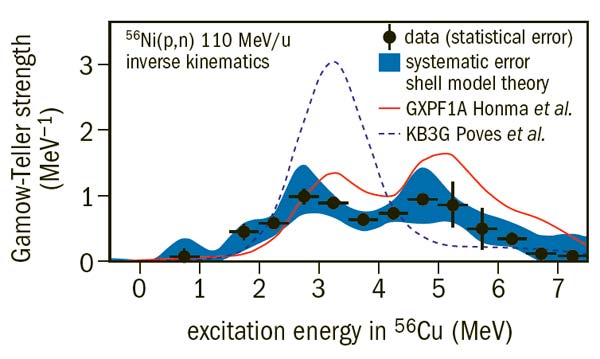
A team at the National Superconducting Cyclotron Laboratory (NSCL) at Michigan State University has developed a new experimental technique for measuring (p, n) charge-exchange reactions at intermediate energies (˜100 MeV/nucleon) on rare isotopes. The main virtue of the technique is that it can be applied to study the isovector response of rare isotopes of any mass and up to high excitation energies. Previously, charge-exchange experiments with rare isotopes were restricted to light isotopes and final states at low excitation-energies.
The new technique has been applied first to study Gamow-Teller (GT) transitions from 56Ni – an important case for modelling electron-capture rates of interest for the late evolution of core-collapse and thermonuclear supernovae (Sasano et al. 2011 and Langanke 2011). Nuclear charge-exchange reactions at intermediate energies have long been used to study the spin-isospin response of stable nuclei and weak reaction rates, in particular for astrophysical purposes.
To study the (p, n) reaction on the rare nickel isotope, the experiment was performed in inverse kinematics. A beam of 56Ni particles at 110 MeV/u, produced by fast-fragmentation of 58Ni particles from the NSCL coupled-cyclotron facility on a thick production target, was directed at a liquid hydrogen target, which provided the proton “probe”. The newly constructed Low-Energy Neutron Detector Array detected recoil neutrons, allowing the excitation energy of the 56Cu reaction product and the centre-of-mass scattering angle to be deduced by measuring the neutron angle and energy. The S800 spectrograph detected heavy fragments (56Cu, or one of its decay products). After isolating the ΔL=0 components of the excitation-energy spectrum via their distinct forward-peaked angular distribution, the team was able to extract the GT transition strength, using the well established proportionality between the differential cross-section at vanishing momentum transfer and the GT strength.
The figure shows the extracted GT strength as a function of excitation energy and the comparison with two shell-model calculations based on different Hamiltonians. Because isospin symmetry-breaking effects are small and 56Ni has isospin I=0, the strength distribution for the 56Ni→56Cu reaction is nearly identical to that for the 56Ni→56Co reaction. The latter is of relevance for electron captures in stellar environments, while 56Ni plays a central role in the studies of weak reaction rates for supernovae. By benchmarking and improving the shell-model calculations for the N=Z=28 nucleus 56Ni, more reliable calculations of electron-capture rates for many nuclei in the iron group will be possible.
Further reading
M Sasano et al. 2011 Phys. Rev. Lett. 107 202501.
K Langanke 2011 Physics 4 91.








